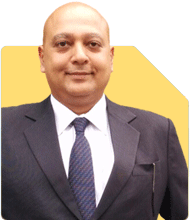Should I ask for my money back after the contractor I hired for home repairs left me with a lot of damage?
Ramalingam Kalirajan |8285 Answers |Ask -Follow
Mutual Funds, Financial Planning Expert - Answered on Jan 02, 2025
He has an MBA in finance from the University of Madras and is a certified financial planner.
He is the director and chief financial planner at Holistic Investment, a Chennai-based firm that offers financial planning and wealth management advice.... more

I have taken a loan of 15 lakh from office and I have salary of Rs 66000 per month.How I can pay this loan I need to clear it soon
Assessing Your Financial Position
1. Calculate EMI and Loan Tenure
Confirm your monthly EMI and loan tenure.
Ensure you know the interest rate and prepayment rules.
2. Review Monthly Budget
Analyse your income and expenses thoroughly.
Identify areas where you can save more.
3. Assess Additional Income Sources
Explore opportunities for extra income.
Look for freelance work, weekend jobs, or monetising hobbies.
Short-Term Strategies to Accelerate Loan Repayment
1. Allocate a Fixed Repayment Amount
Dedicate a significant portion of your salary to EMIs.
Prioritise the loan in your financial planning.
2. Cut Non-Essential Expenses
Reduce discretionary spending like dining out and entertainment.
Focus on needs over wants during the repayment period.
3. Use Bonuses or Windfalls
Use salary bonuses or incentives for partial loan repayment.
Any extra income should be directed towards the loan.
4. Avoid New Debt
Do not take additional loans or use credit cards unnecessarily.
Focus only on clearing the existing loan.
Medium-Term Actions for Loan Reduction
1. Increase EMI Amount
Check if you can increase EMI without penalties.
Higher EMIs reduce tenure and interest costs.
2. Make Regular Prepayments
Use savings to prepay the loan in small chunks.
Prepayment reduces both principal and interest burden.
3. Create a Strict Budget
Track all expenses and limit unnecessary costs.
Allocate every rupee wisely towards loan repayment.
4. Seek Office Assistance
Request for a longer repayment period if you face financial strain.
Ensure the EMI remains manageable.
Long-Term Measures for Financial Stability
1. Build an Emergency Fund
Save for emergencies once the loan reduces.
Aim for 3–6 months’ worth of expenses.
2. Focus on Income Growth
Invest in skill development to increase your earning potential.
Look for promotions or better-paying job roles.
3. Adopt Financial Discipline
Avoid unnecessary expenses or impulsive purchases.
Plan for future needs to avoid taking new loans.
Risks of Default
1. Financial Stress
Missing EMIs can lead to stress and additional penalties.
Ensure timely payments to avoid complications.
2. Workplace Reputation
Office loans are based on trust.
Defaulting can impact your professional relationships.
3. Reduced Liquidity
High EMIs can strain your cash flow.
Create a backup plan to manage shortfalls.
Final Insights
Repaying Rs. 15 lakh requires focus, discipline, and strategic planning. Prioritise loan repayment by cutting expenses, using additional income, and making prepayments. Long-term financial discipline ensures you avoid such debt burdens again. Consulting a Certified Financial Planner can help you create a customised financial roadmap for loan repayment and future stability.
Best Regards,
K. Ramalingam, MBA, CFP,
Chief Financial Planner,
www.holisticinvestment.in
https://www.youtube.com/@HolisticInvestment
You may like to see similar questions and answers below
Ramalingam Kalirajan |8285 Answers |Ask -Follow
Mutual Funds, Financial Planning Expert - Answered on May 20, 2024
Ramalingam Kalirajan |8285 Answers |Ask -Follow
Mutual Funds, Financial Planning Expert - Answered on May 20, 2024
Ramalingam Kalirajan |8285 Answers |Ask -Follow
Mutual Funds, Financial Planning Expert - Answered on Jan 20, 2025
Dr Dipankar Dutta |1165 Answers |Ask -Follow
Tech Careers and Skill Development Expert - Answered on Apr 24, 2025
Dr Dipankar Dutta |1165 Answers |Ask -Follow
Tech Careers and Skill Development Expert - Answered on Apr 24, 2025
Dr Dipankar Dutta |1165 Answers |Ask -Follow
Tech Careers and Skill Development Expert - Answered on Apr 24, 2025
Dr Dipankar Dutta |1165 Answers |Ask -Follow
Tech Careers and Skill Development Expert - Answered on Apr 24, 2025
Vipul Bhavsar |58 Answers |Ask -Follow
Tax Expert - Answered on Apr 24, 2025
Radheshyam Zanwar |1563 Answers |Ask -Follow
MHT-CET, IIT-JEE, NEET-UG Expert - Answered on Apr 24, 2025
Radheshyam Zanwar |1563 Answers |Ask -Follow
MHT-CET, IIT-JEE, NEET-UG Expert - Answered on Apr 24, 2025
Sushil Sukhwani |594 Answers |Ask -Follow
Study Abroad Expert - Answered on Apr 24, 2025
Sushil Sukhwani |594 Answers |Ask -Follow
Study Abroad Expert - Answered on Apr 24, 2025
Sushil Sukhwani |594 Answers |Ask -Follow
Study Abroad Expert - Answered on Apr 24, 2025


















